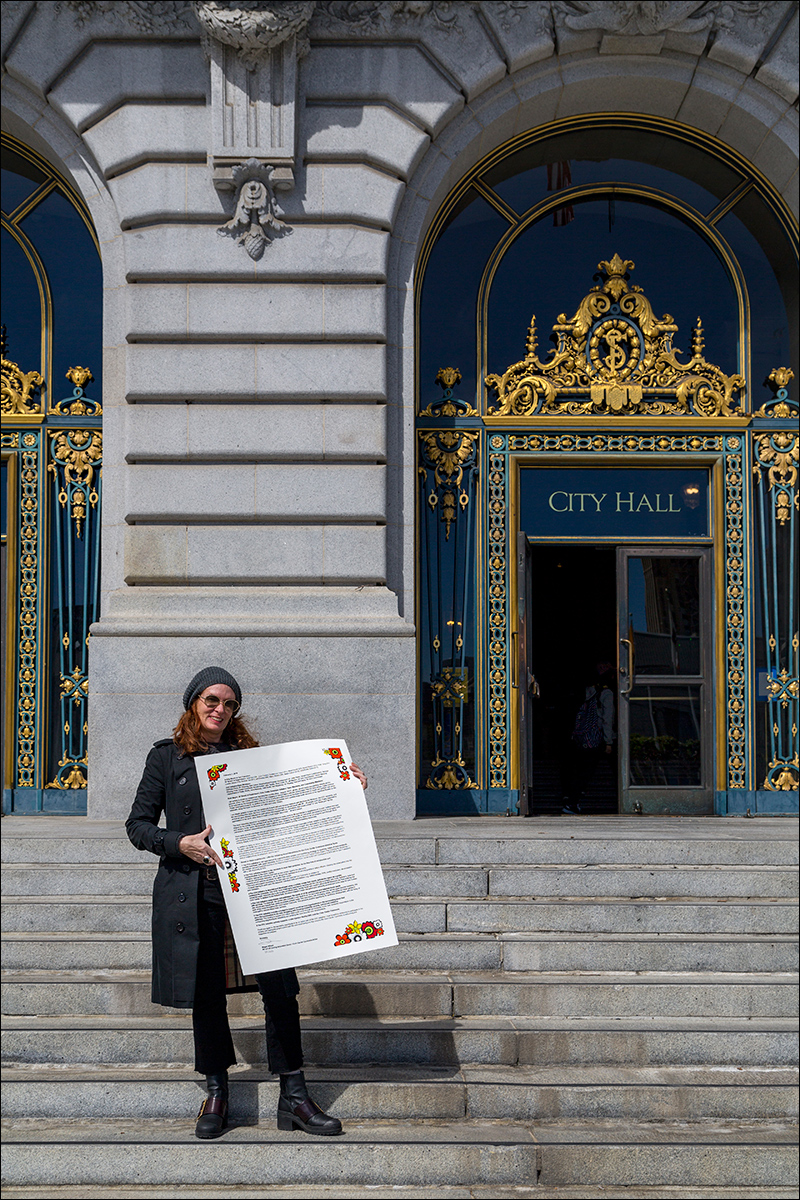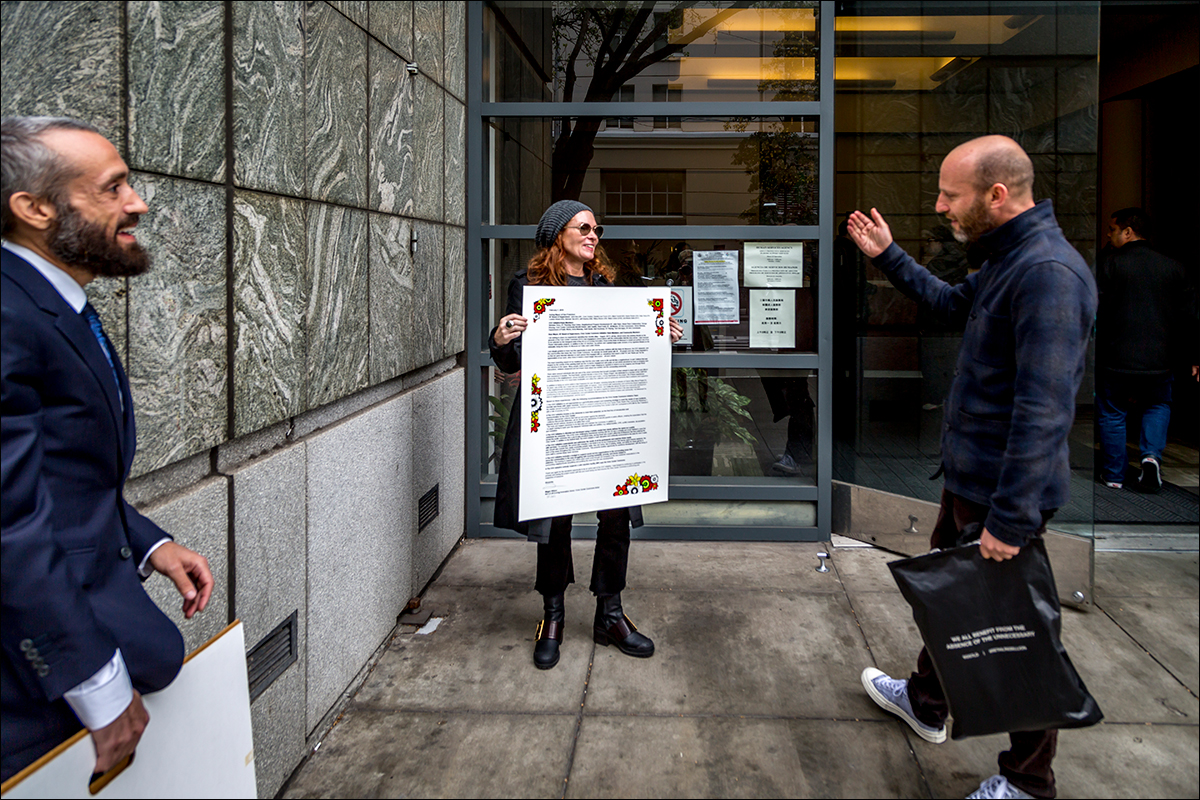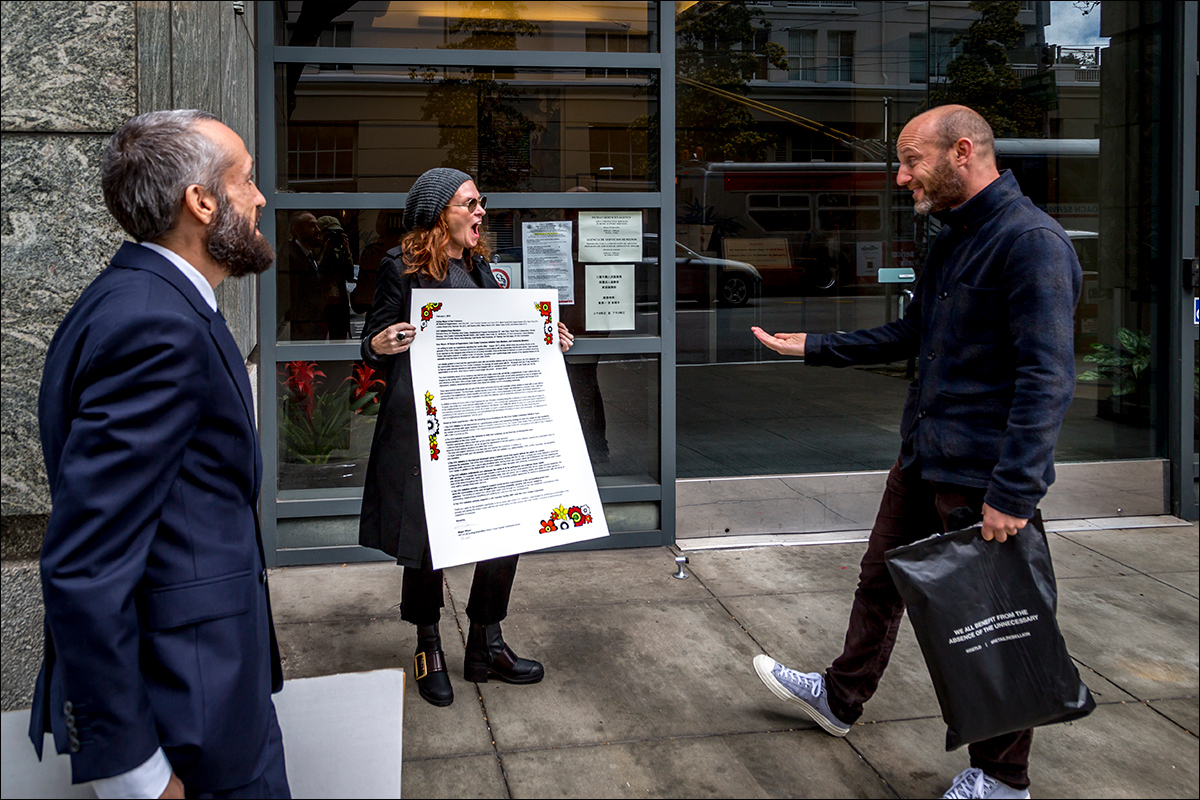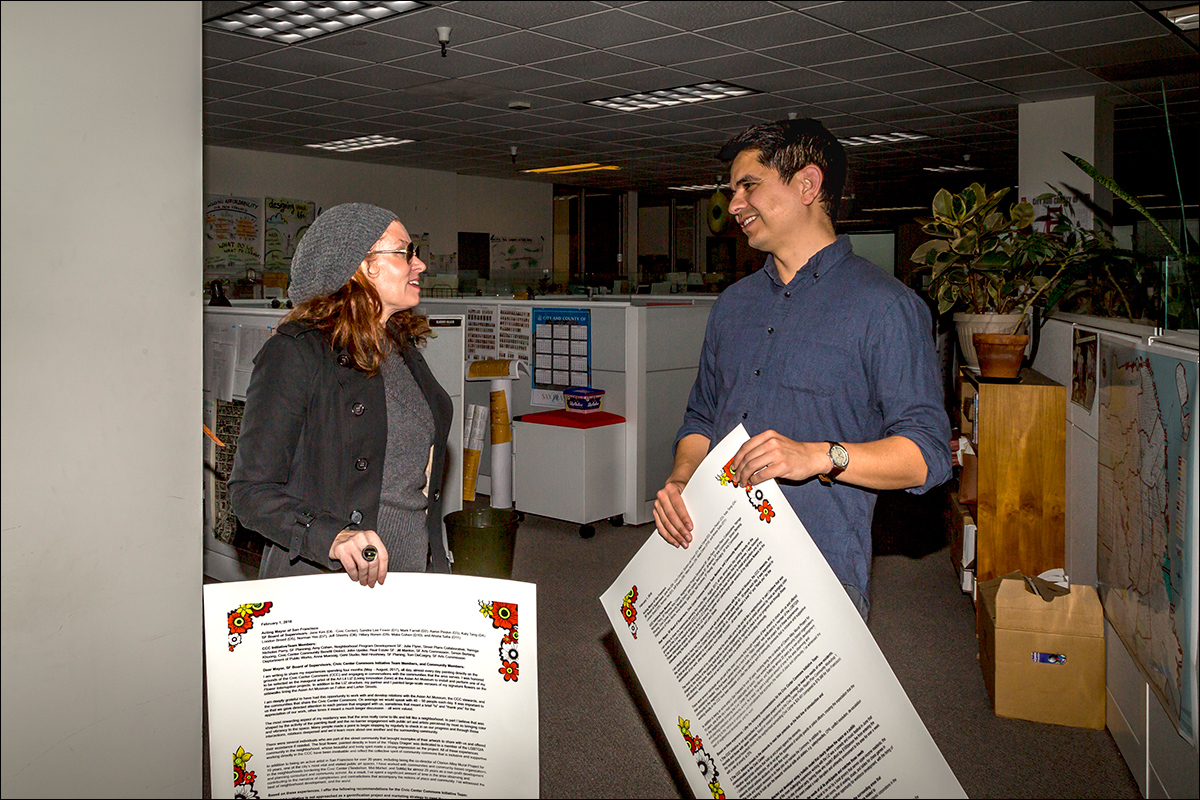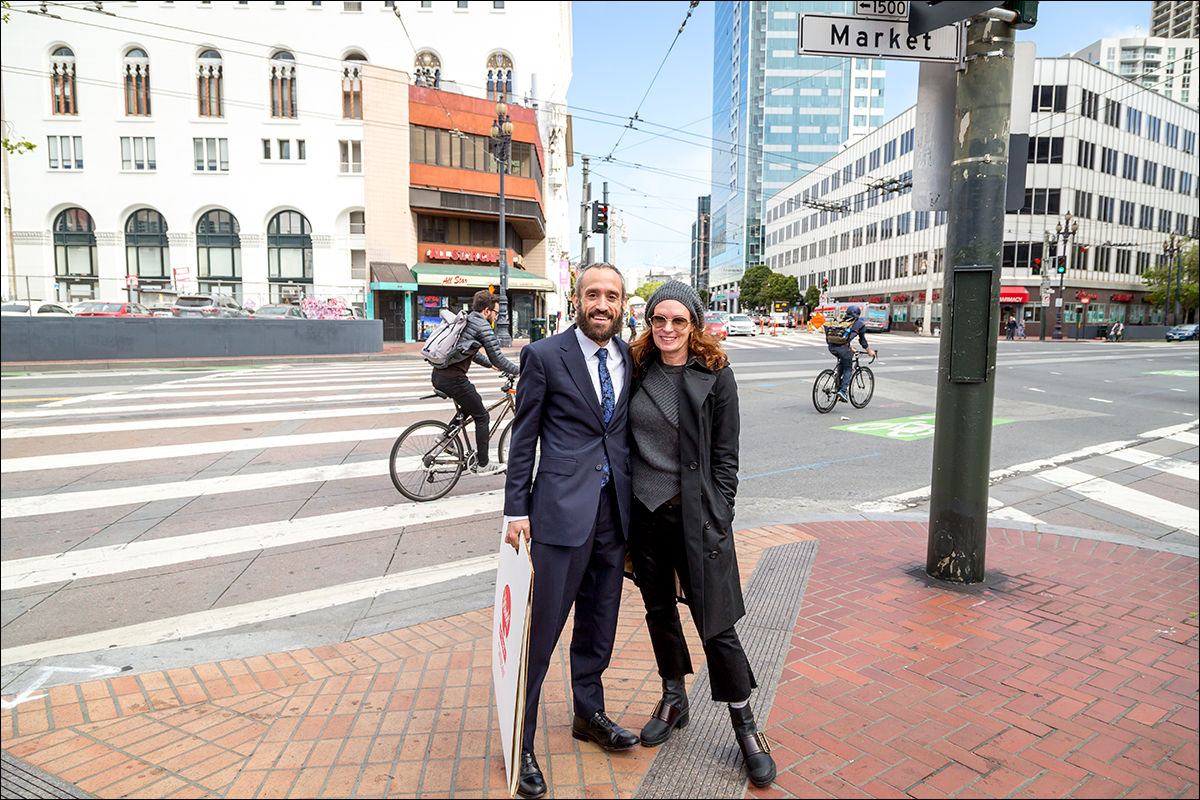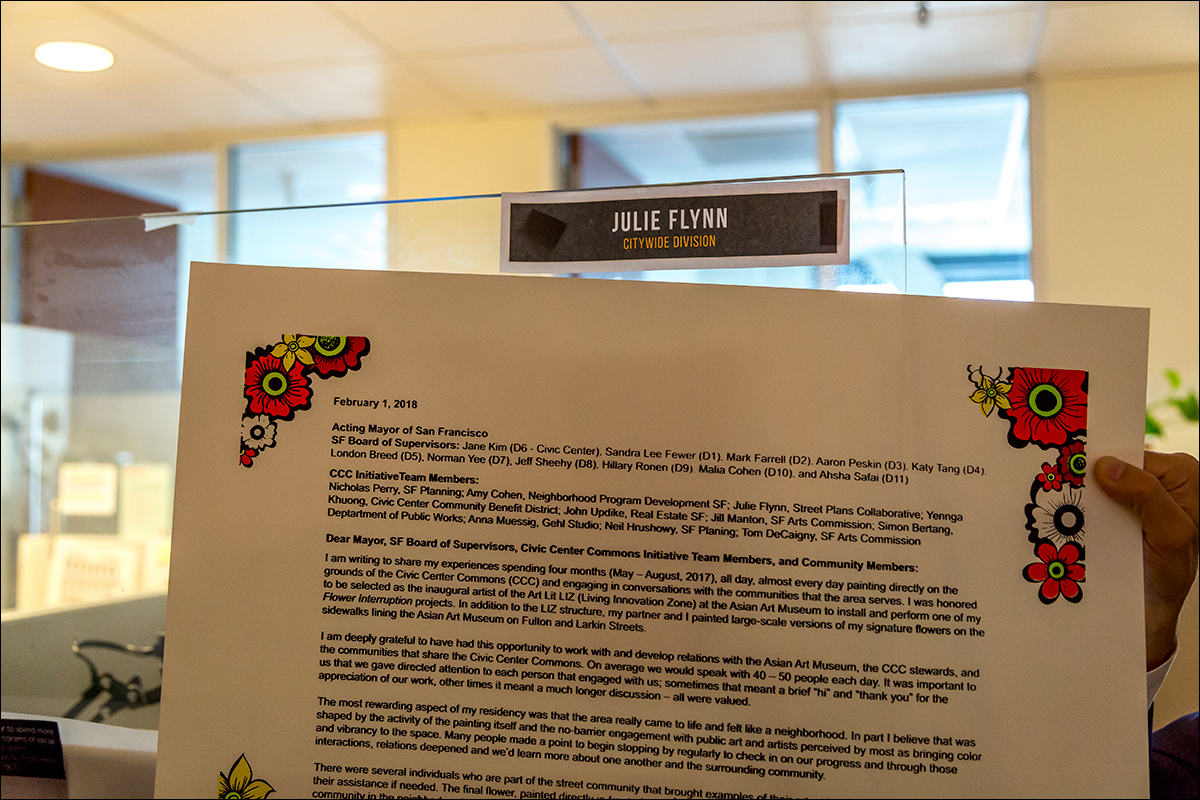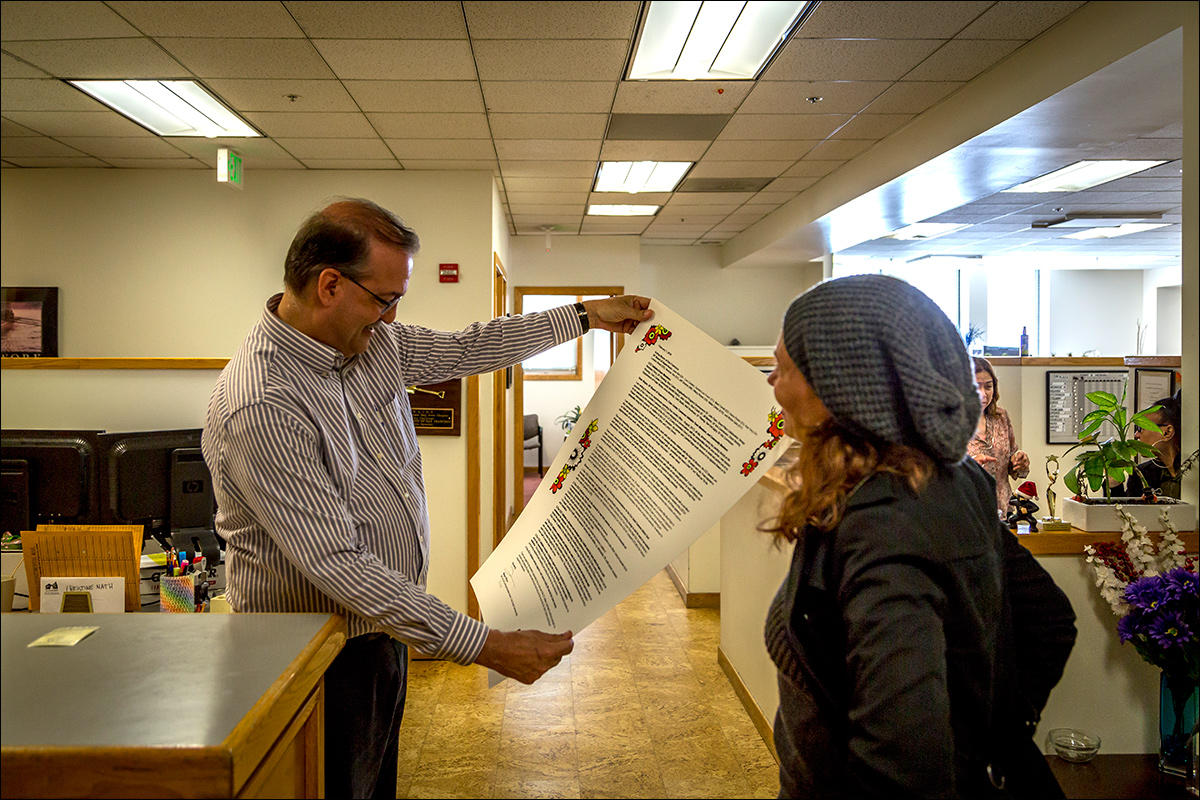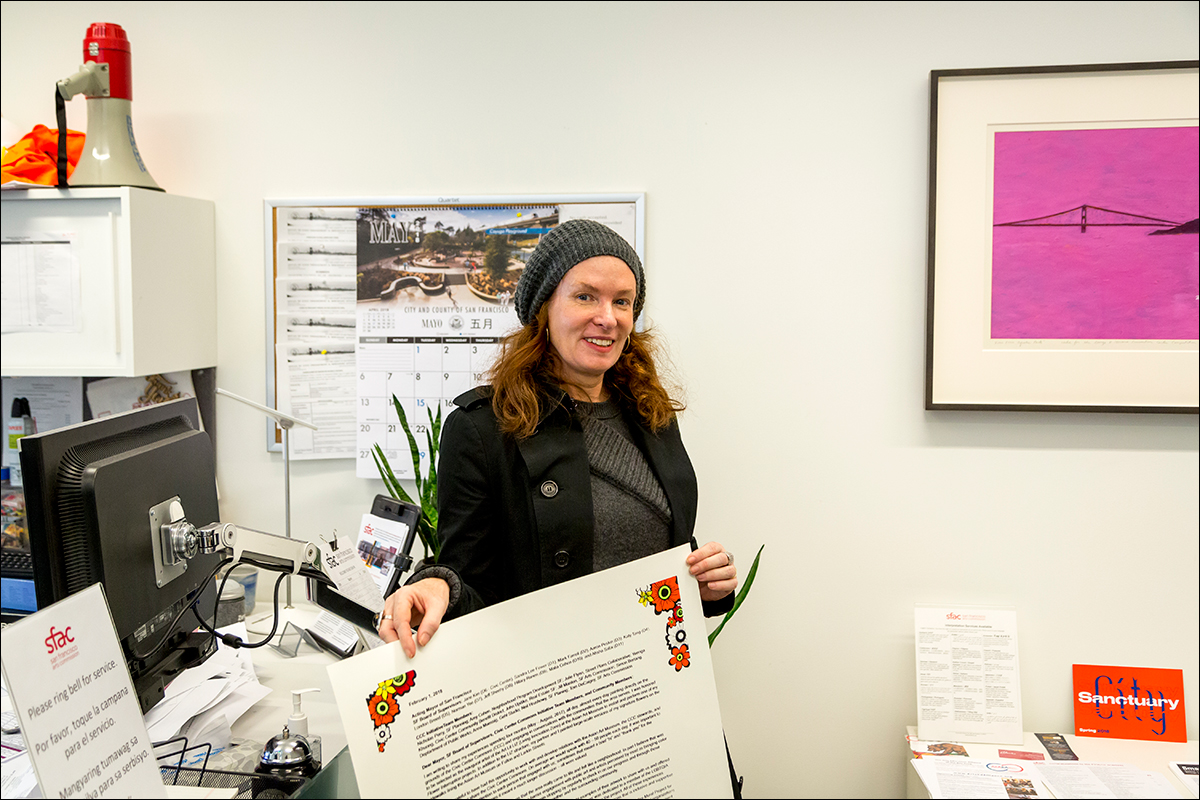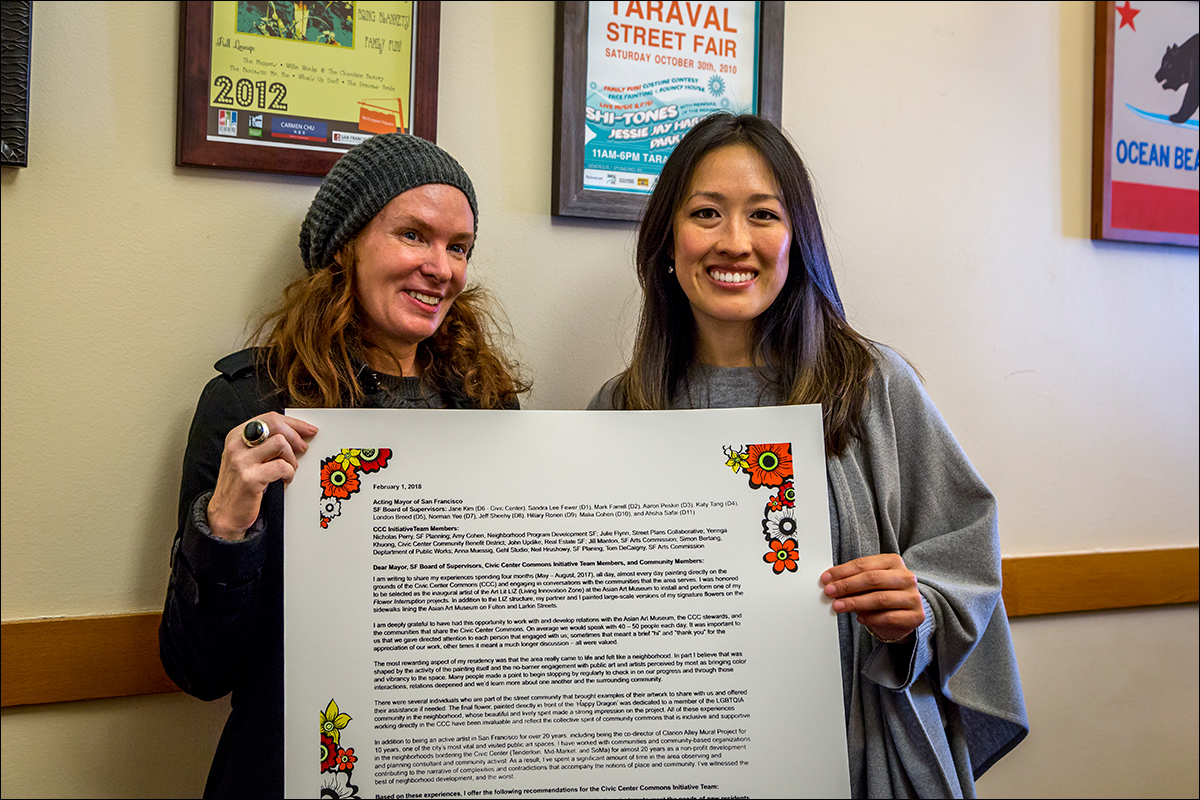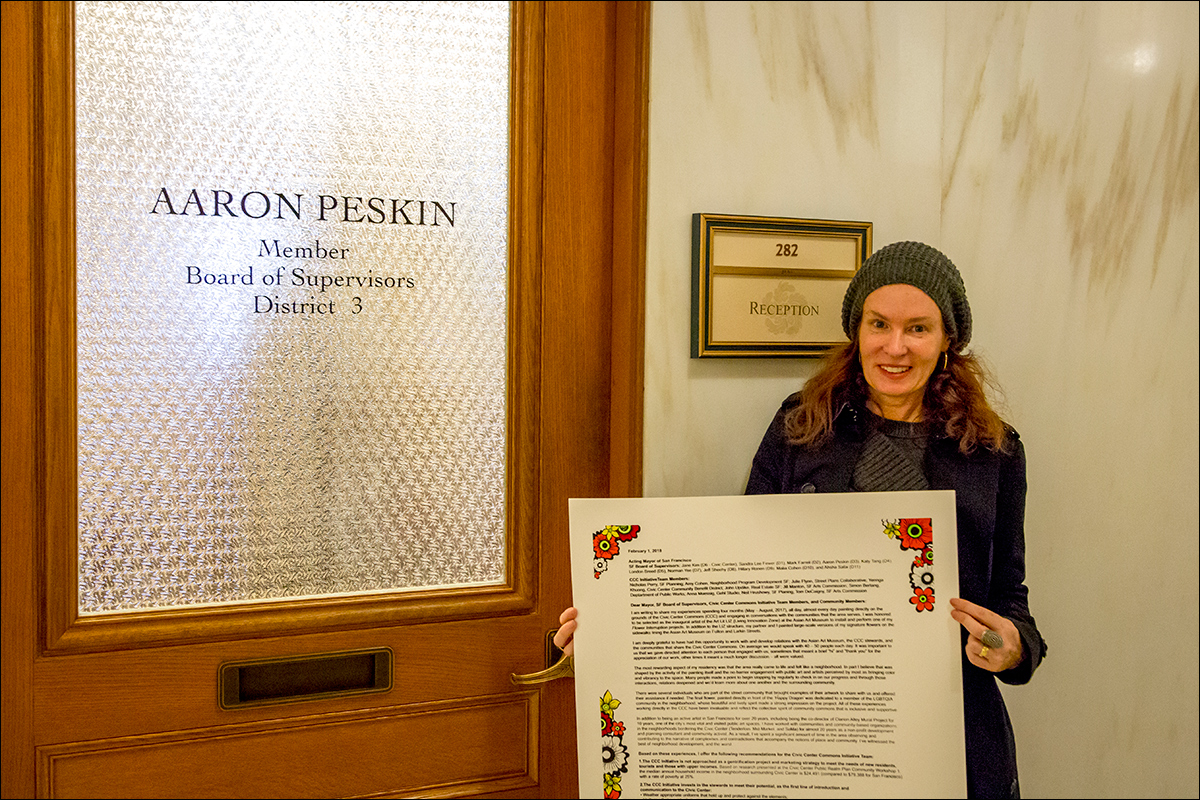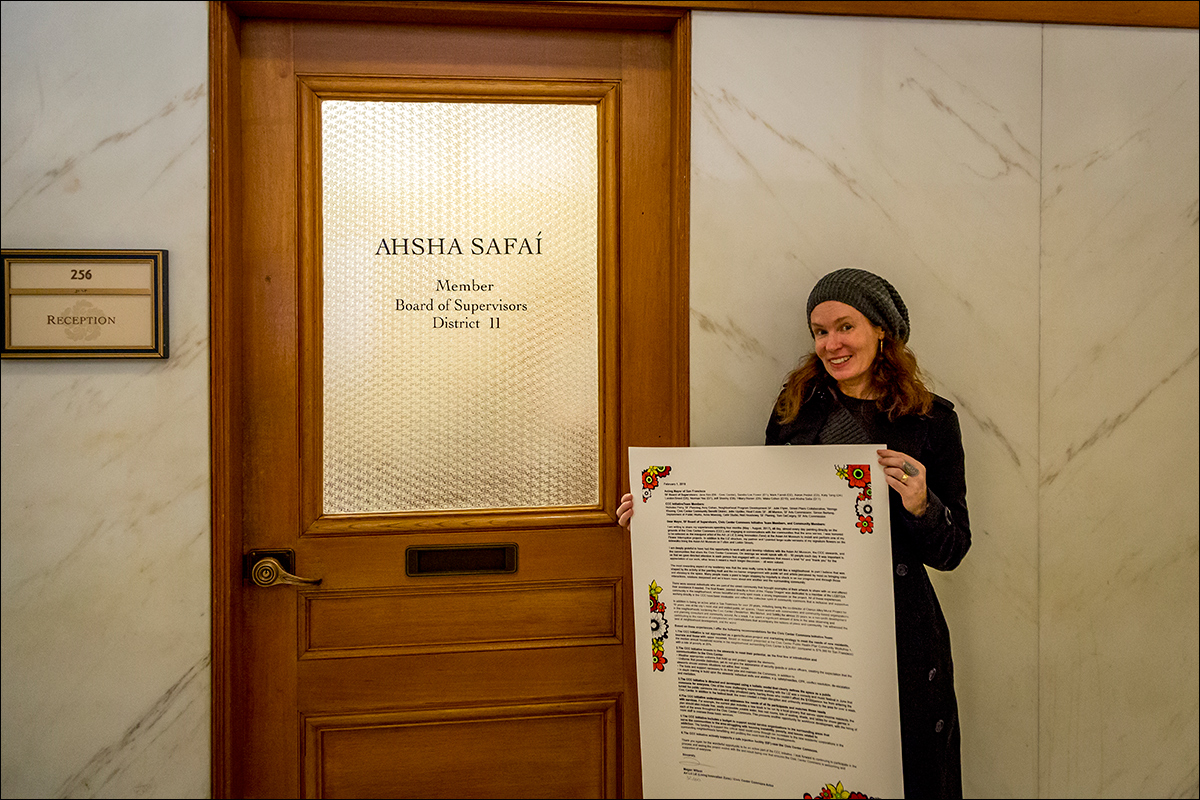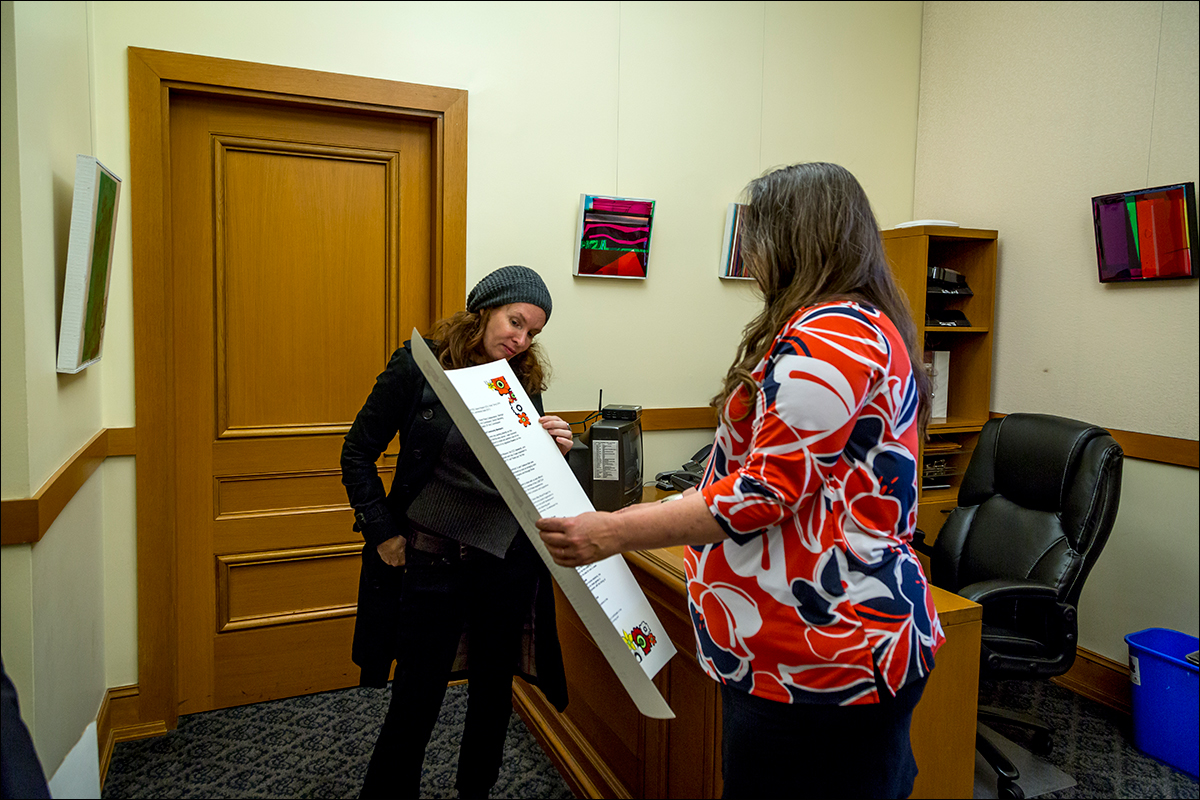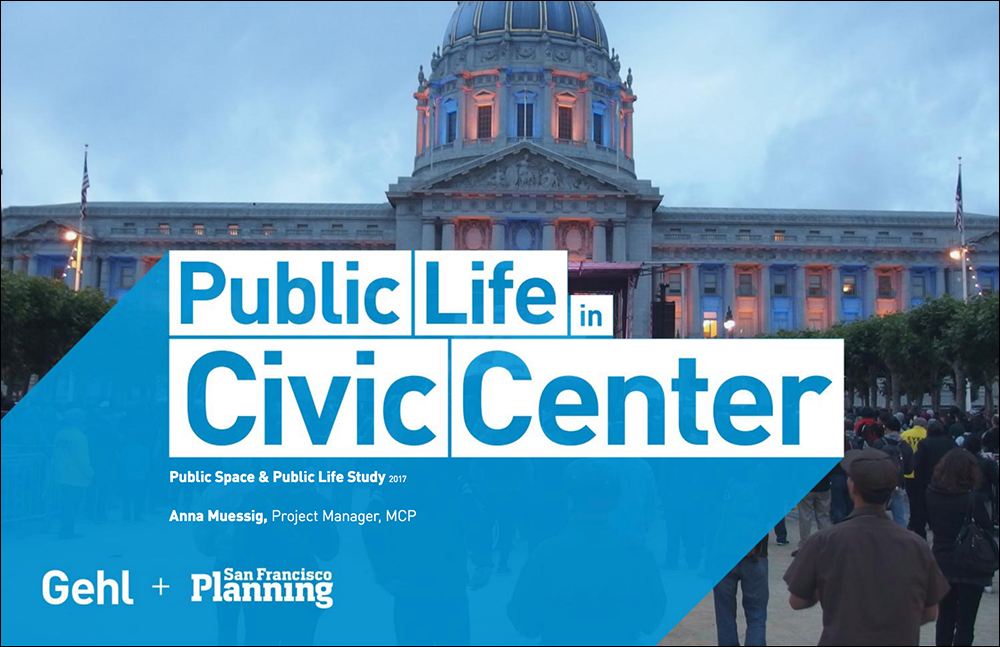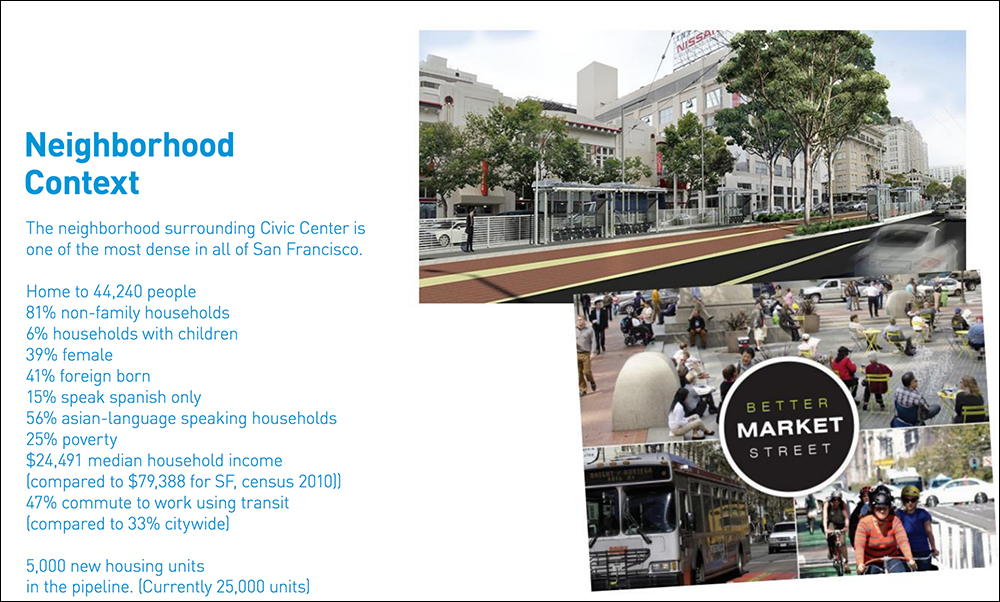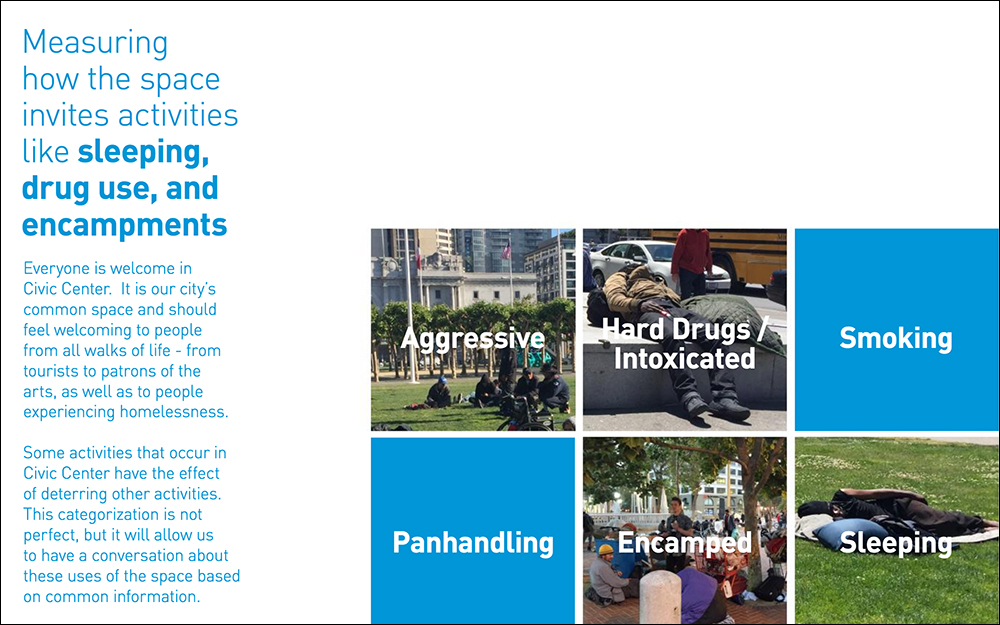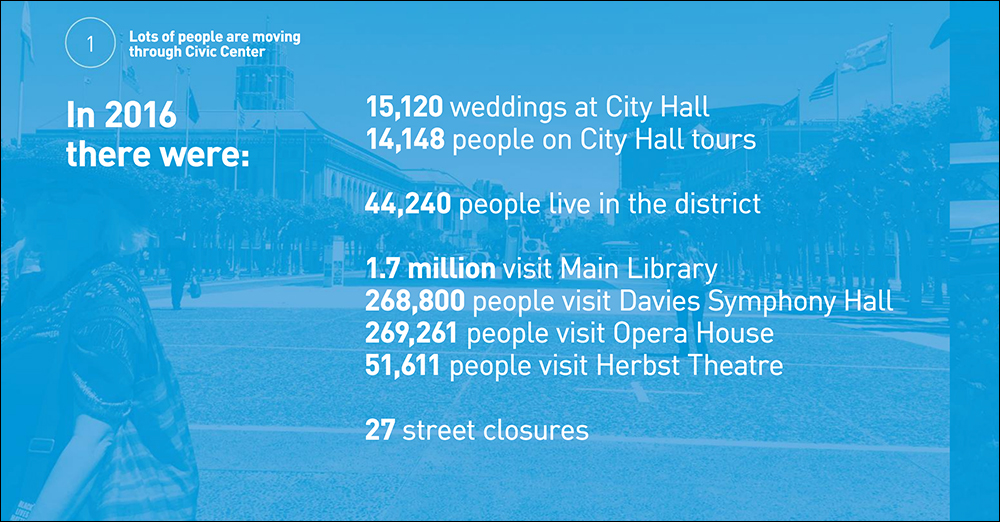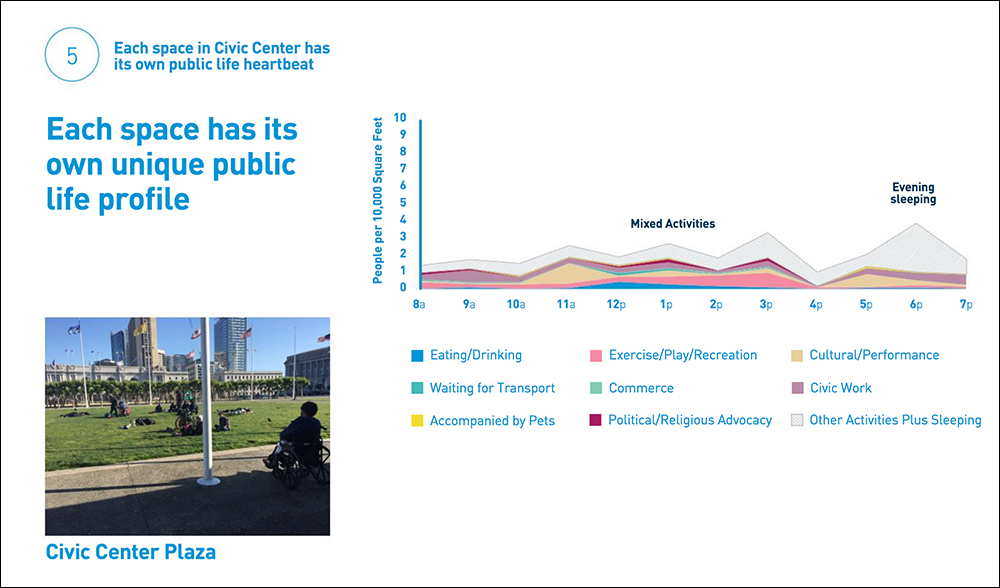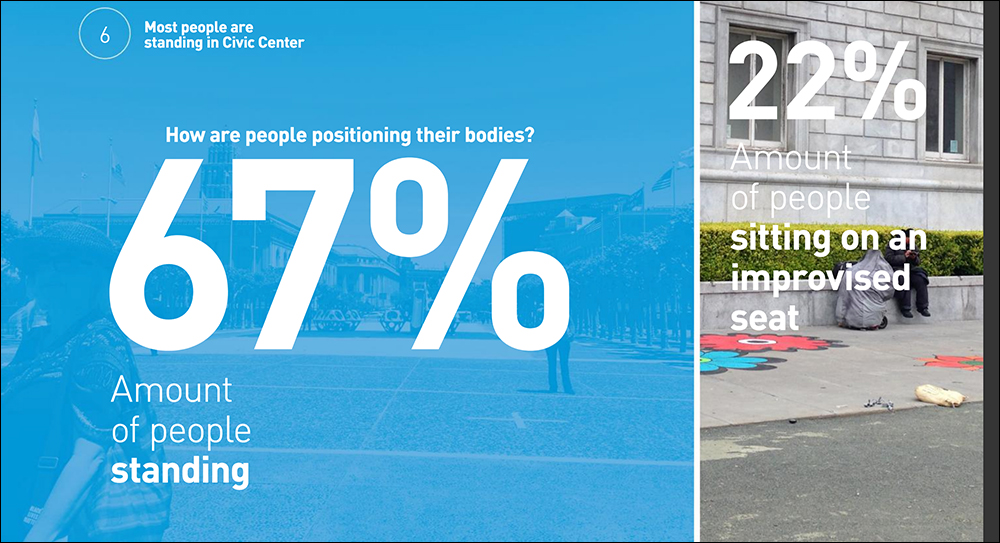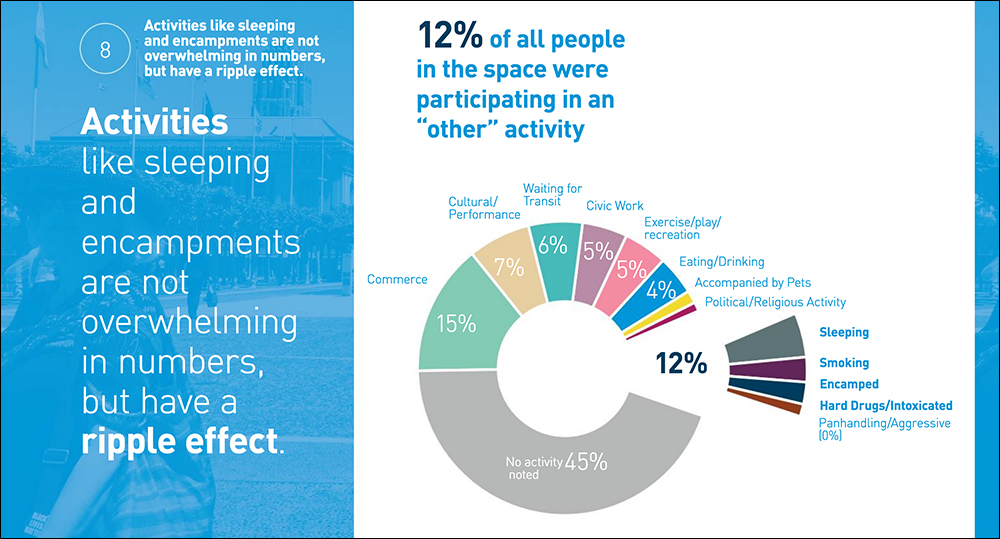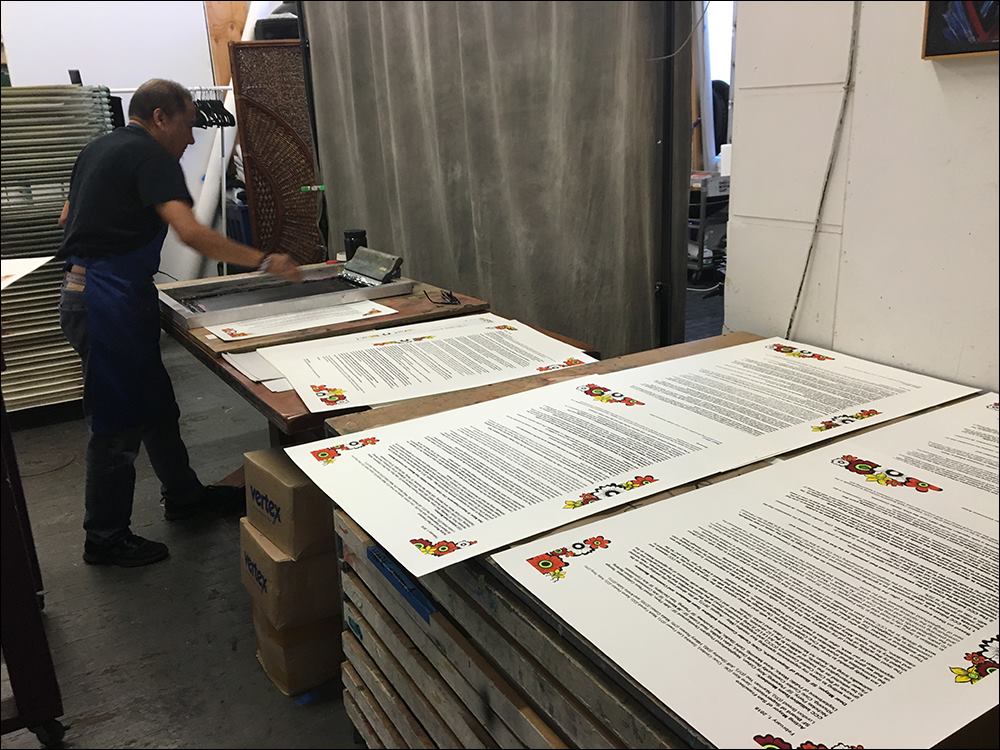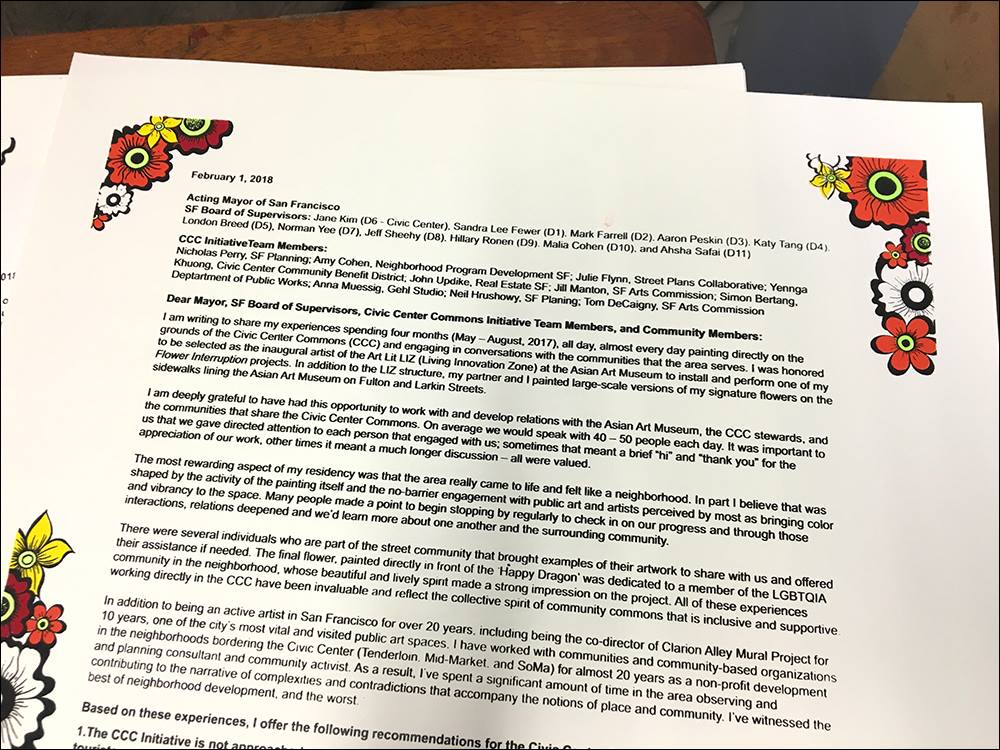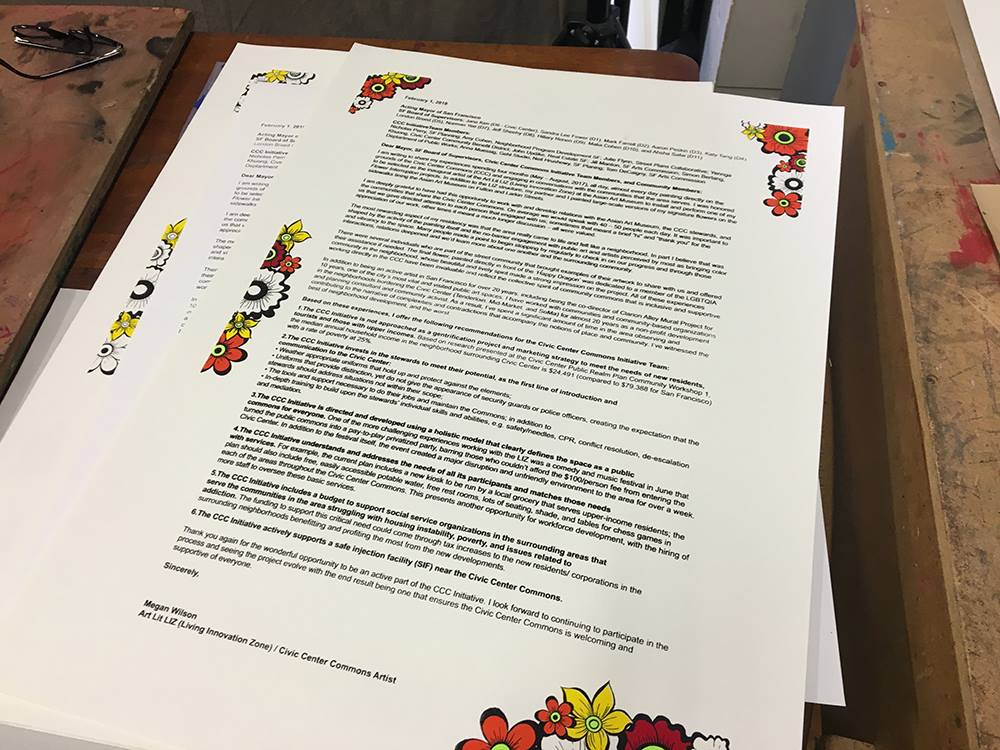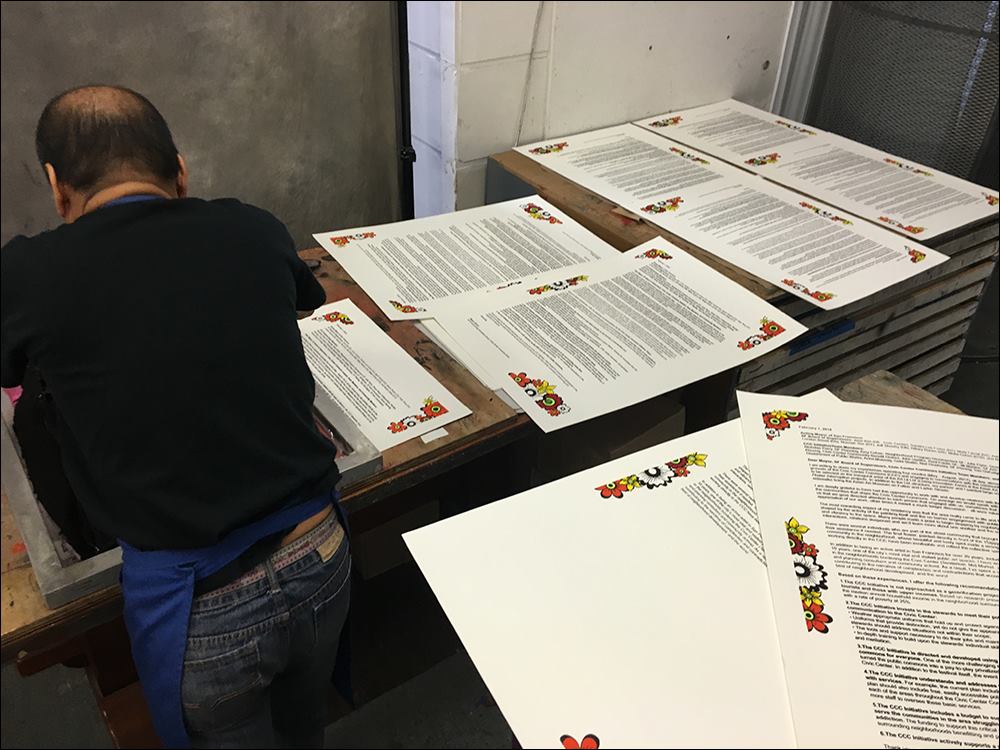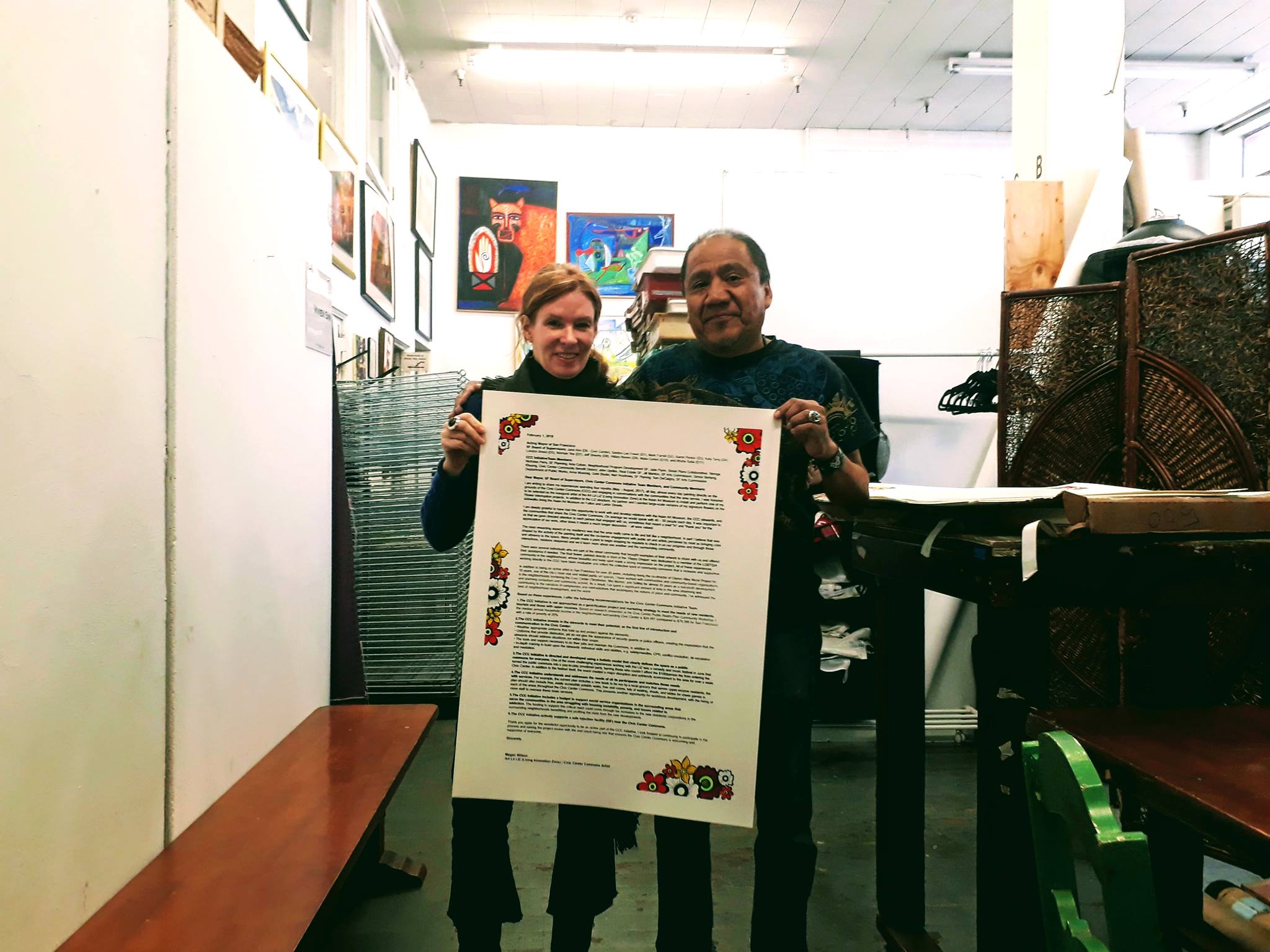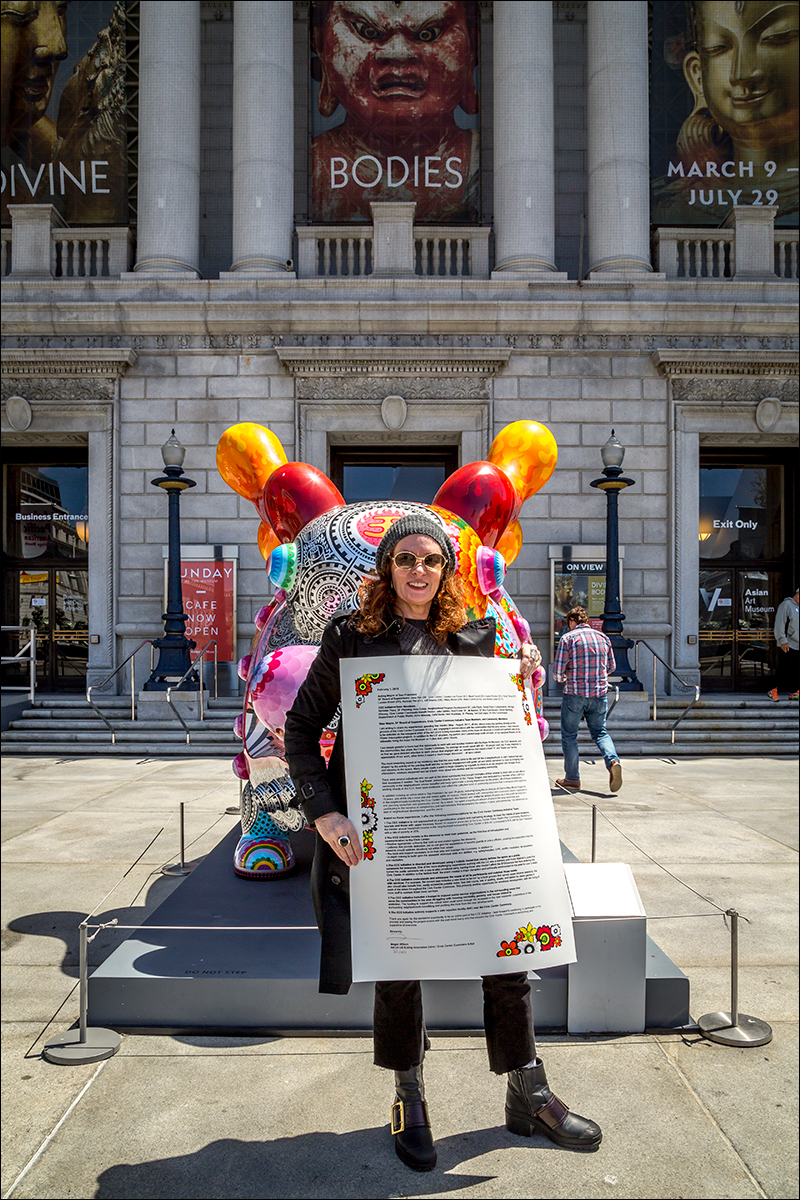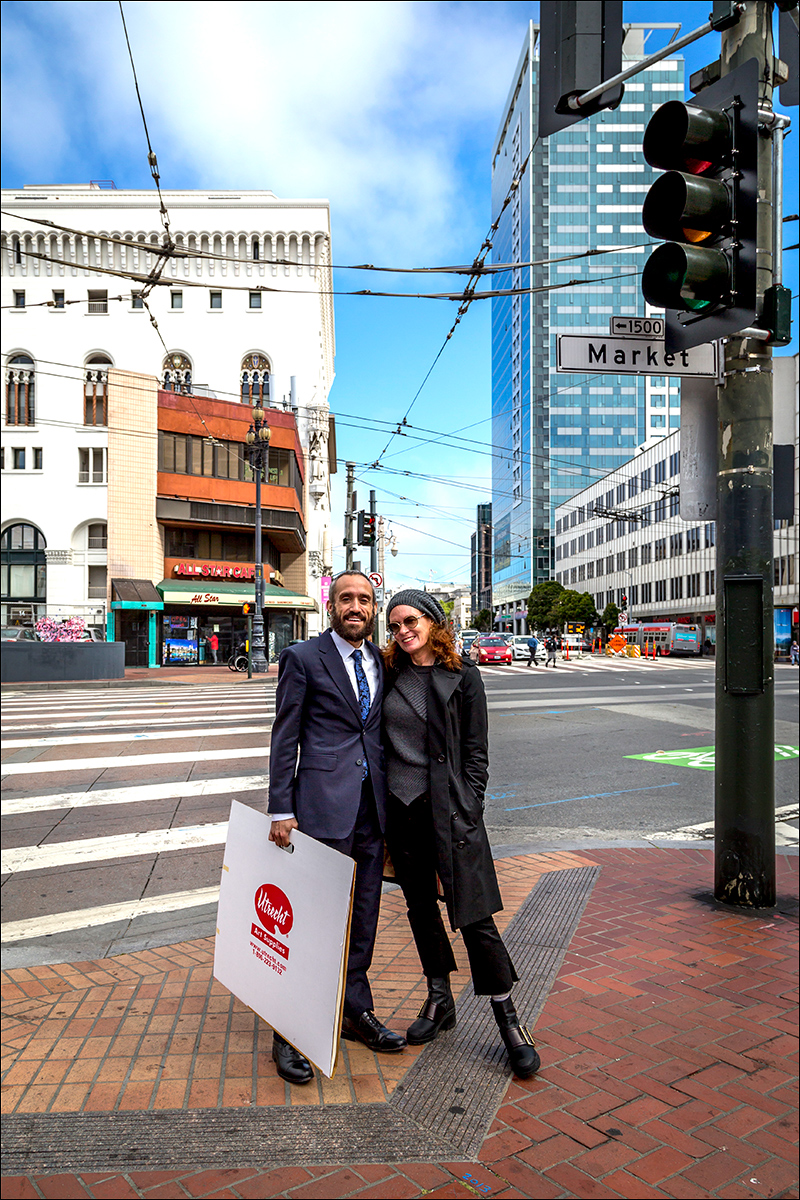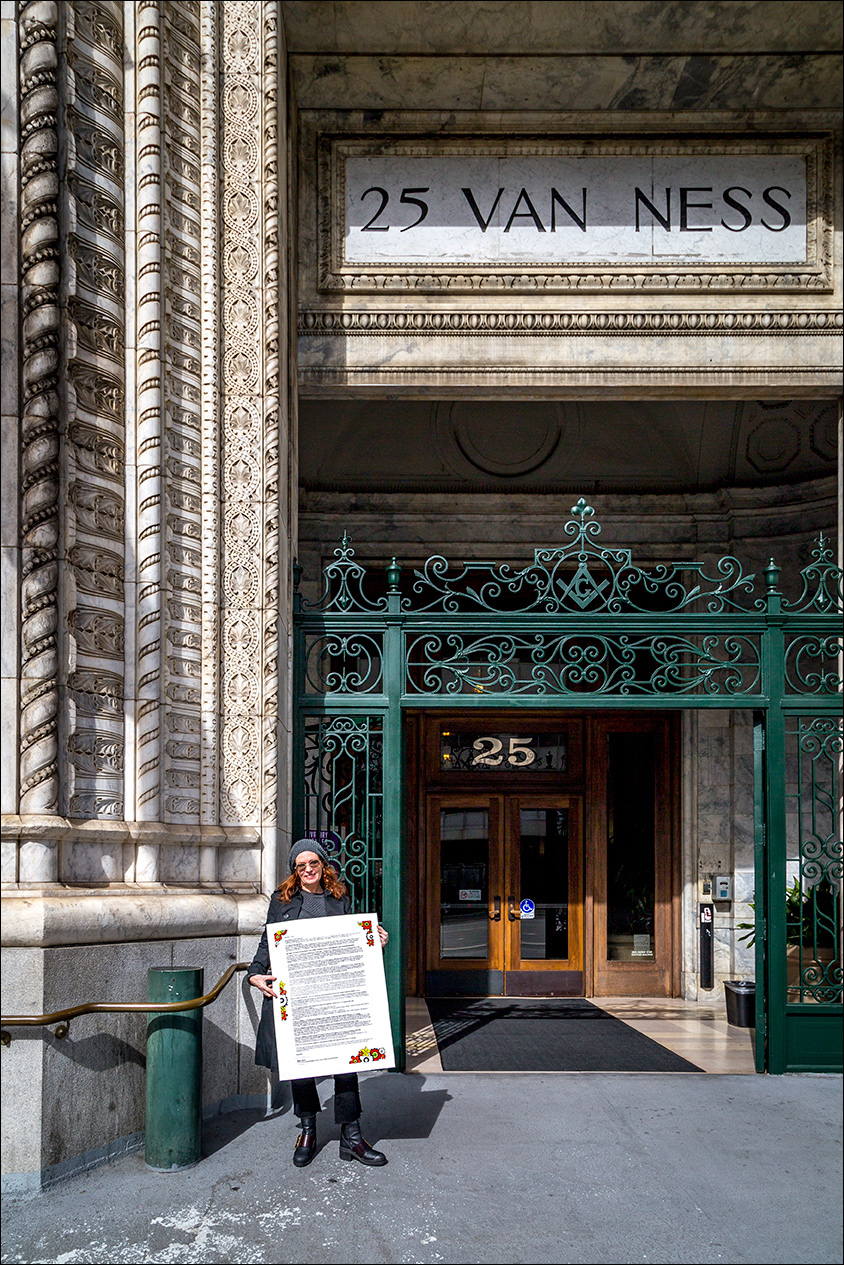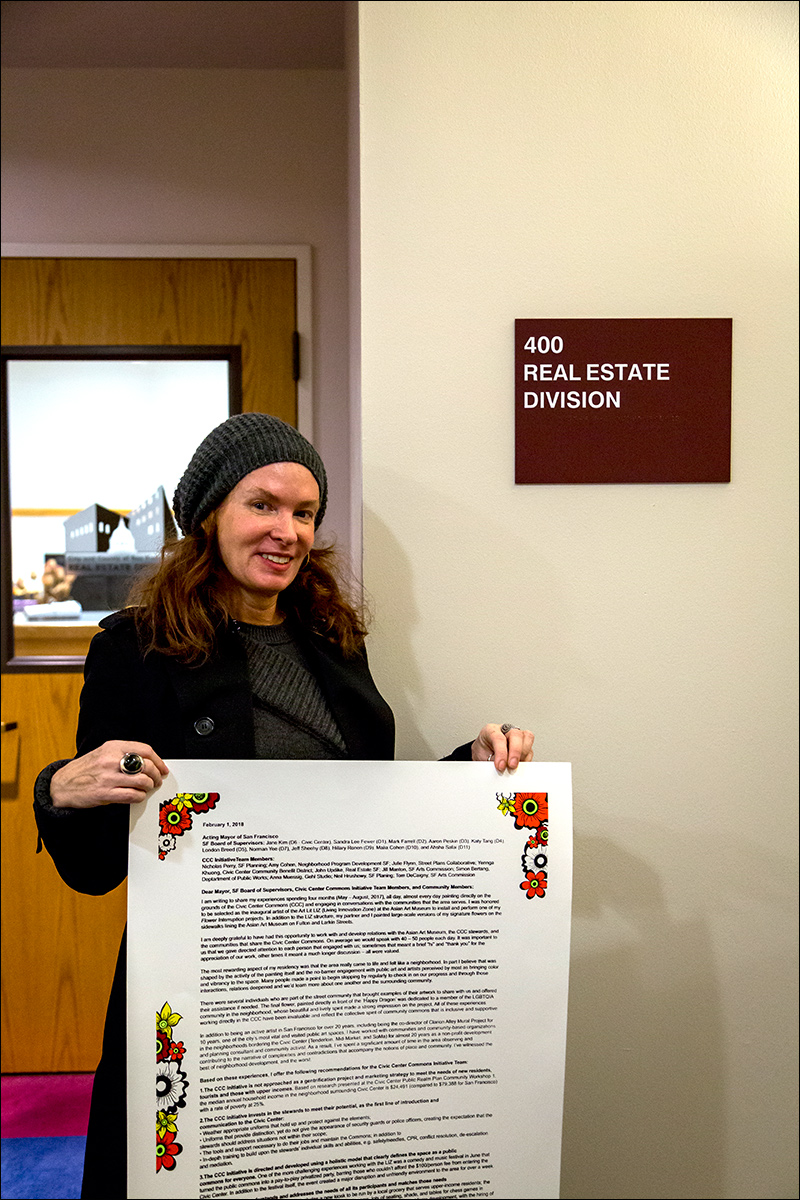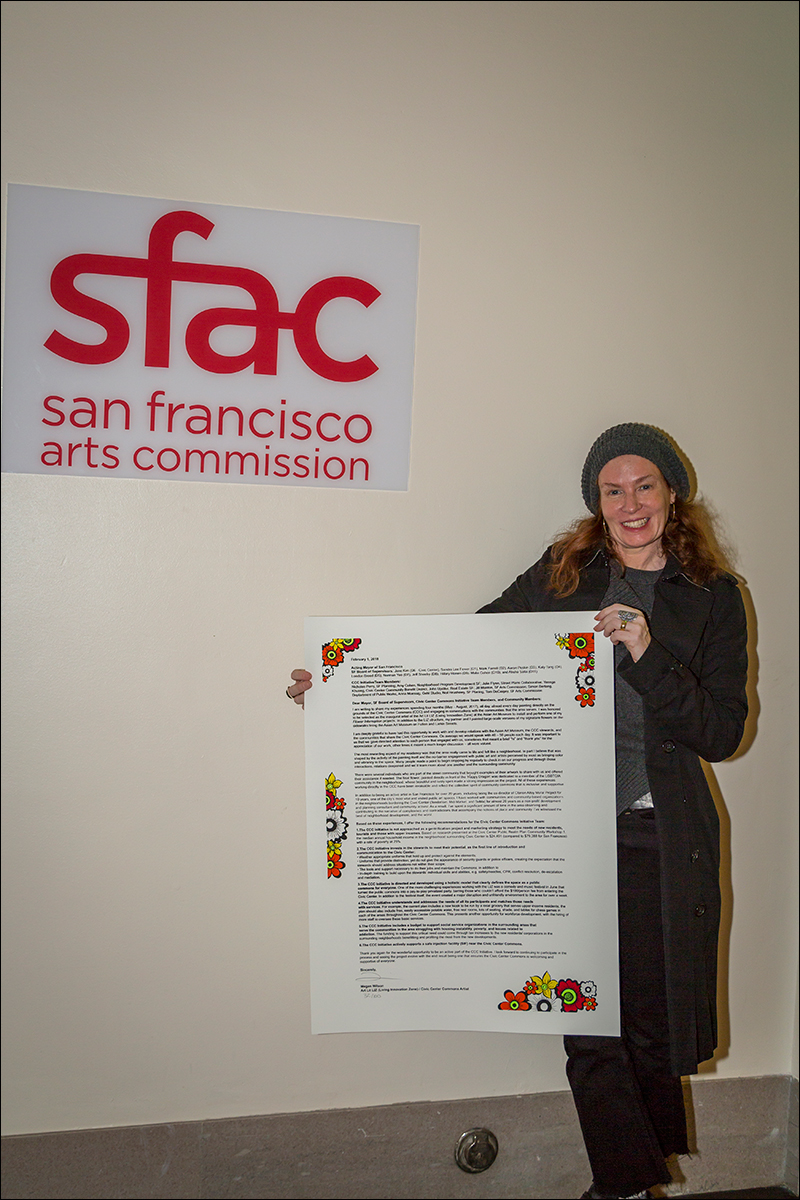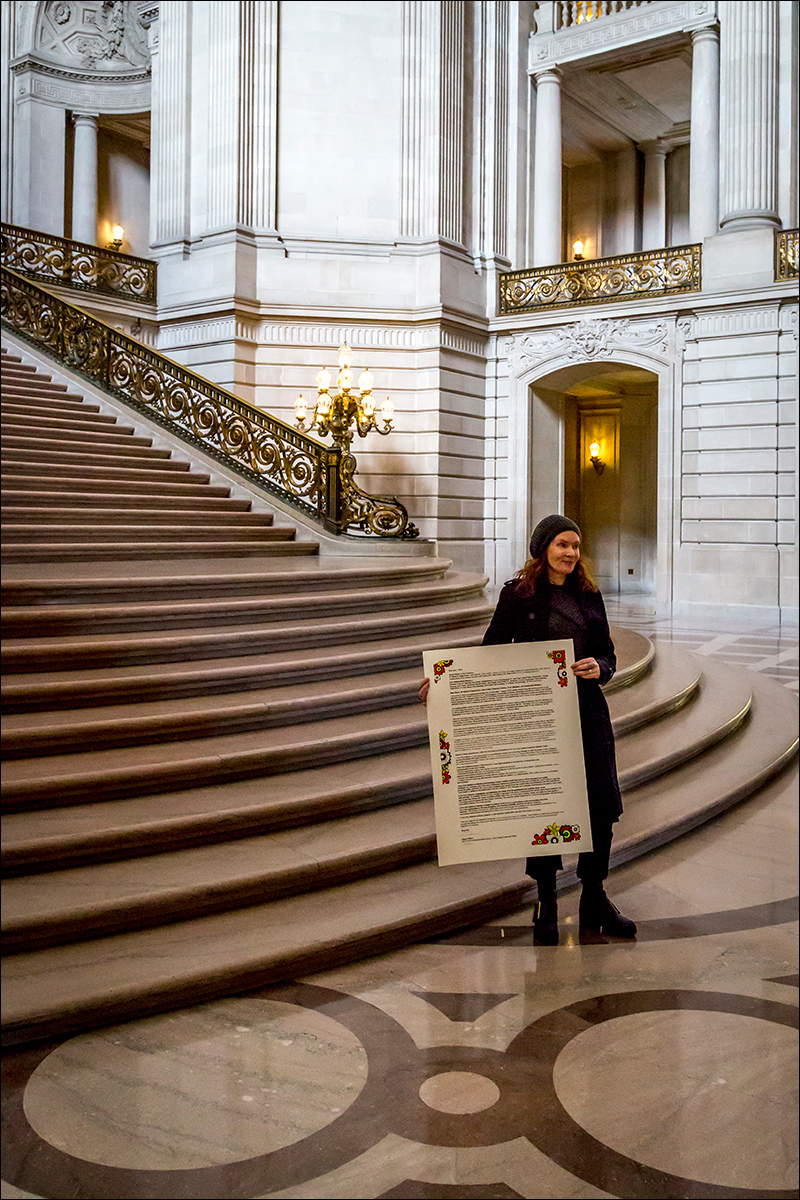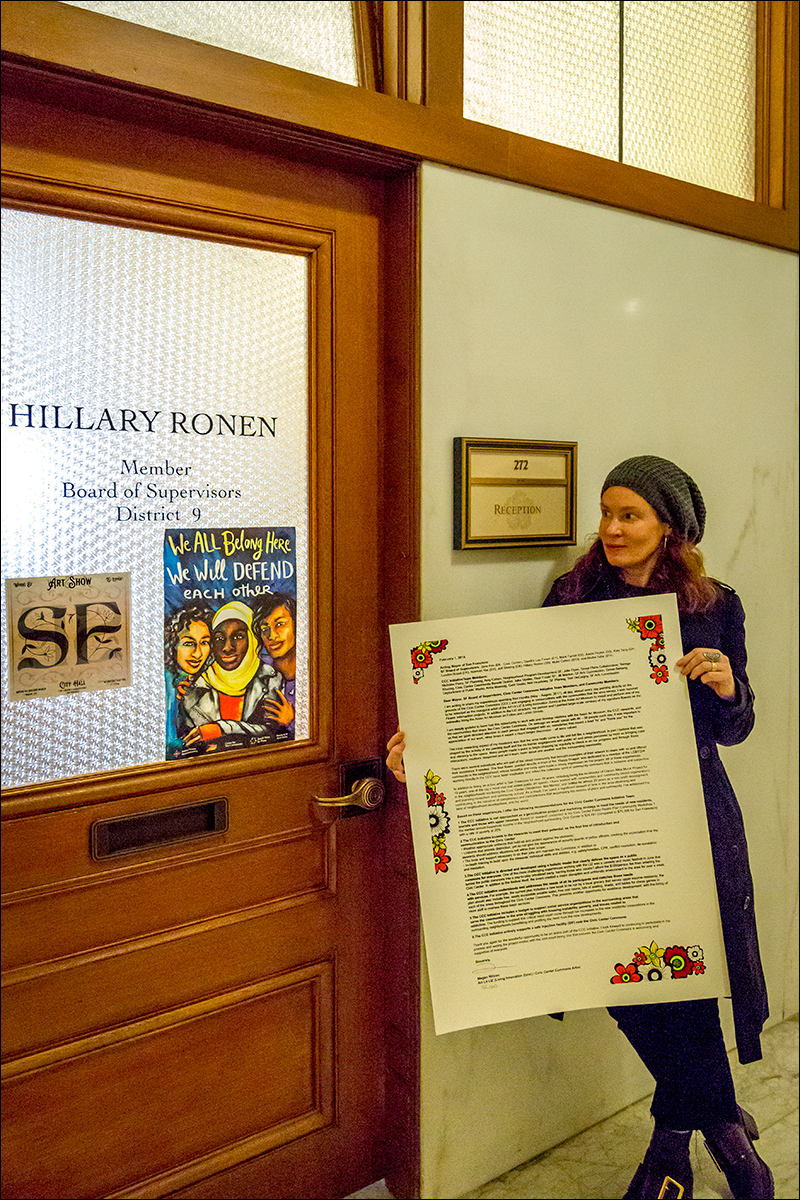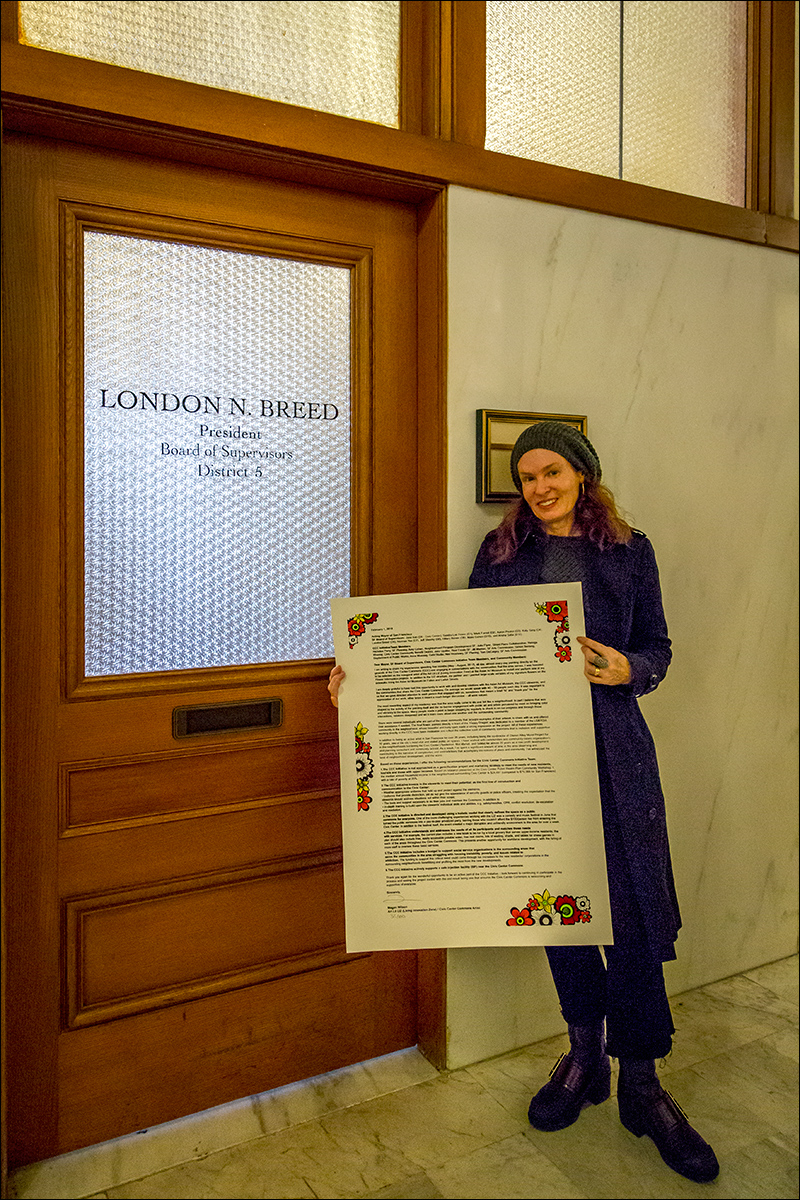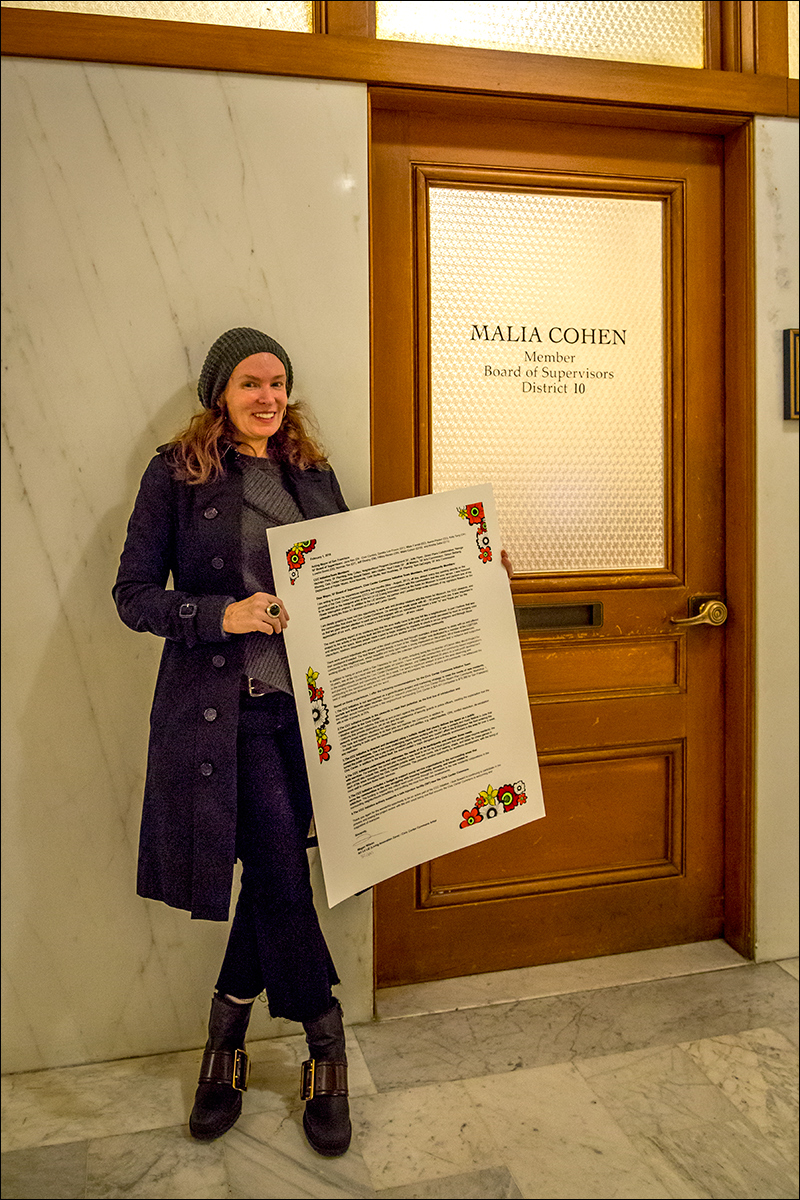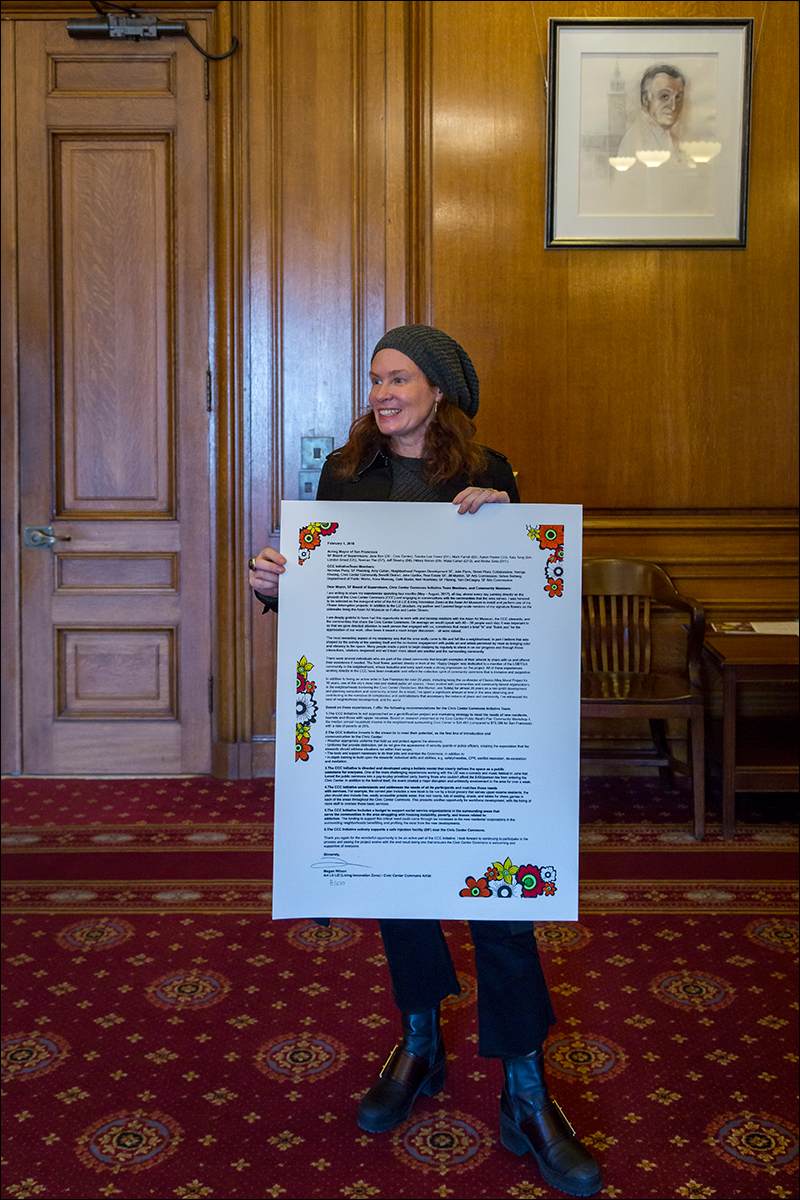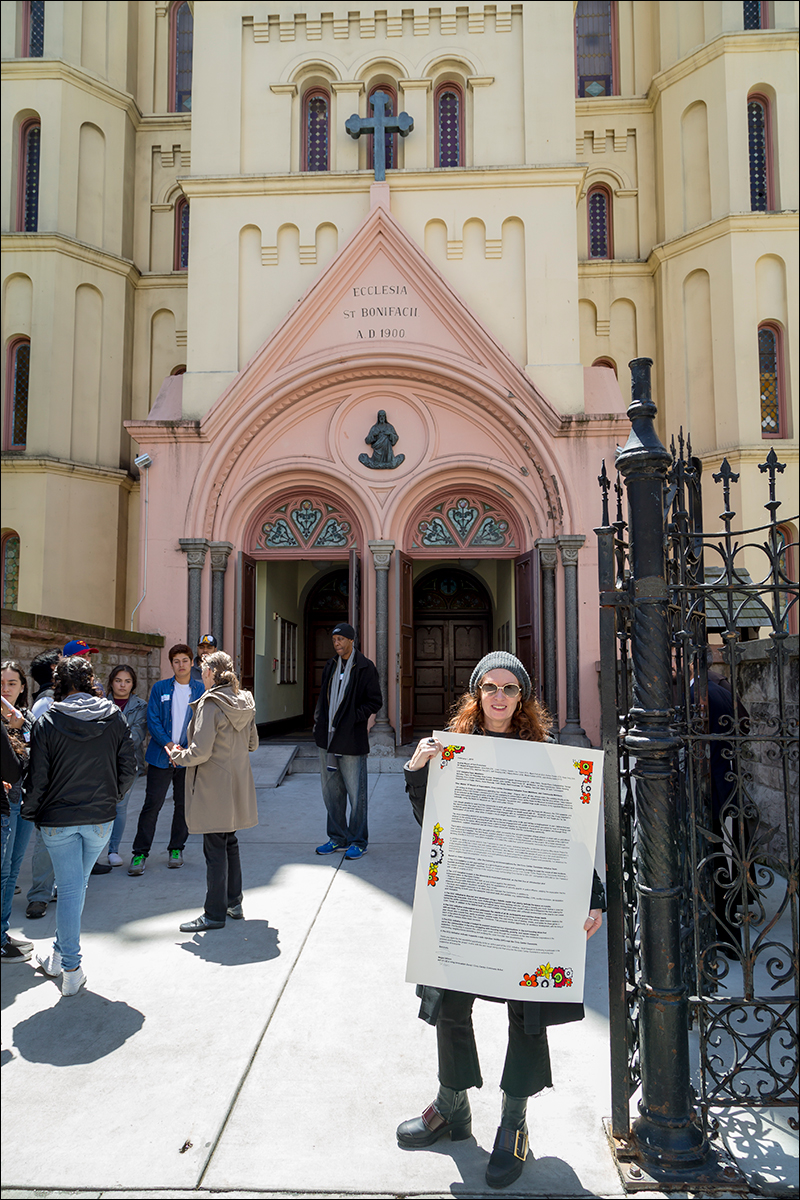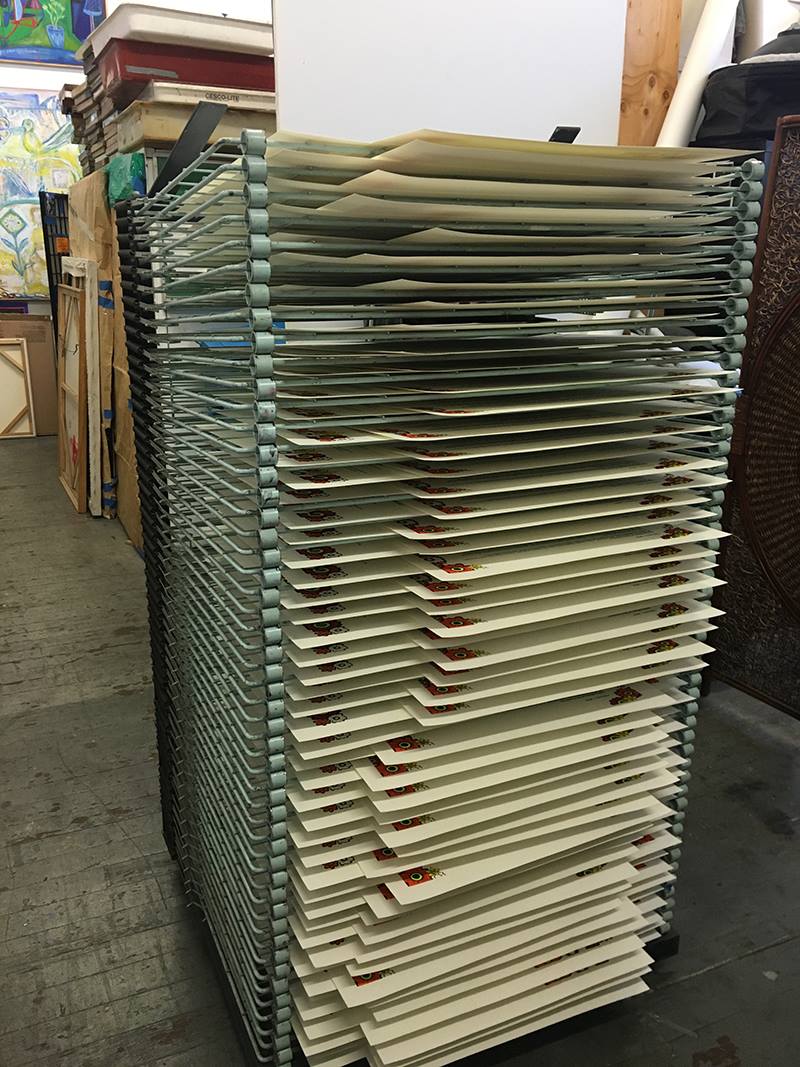Letter to Civic Center Commons Planning Team & City Leaders
Following her residency at the Asian Art Museum, Wilson created A 22" x 30" silkscreened letter/artwork to San Francisco's Mayor, Board of Supervisors, Civic Center Commons leadership team, and stakeholders providing recommendations for the CCC Initiative and the CC Public Realm Plan. Wilson's recommendations are based on having spent four months, all day, almost every day painting directly on the grounds of the Civic Center Commons (CCC) and engaging in conversations with the communities that the area serves. The letter was written and designed by Wilson and printed by master printer Calixto Robles.
Walking along the Flower Interruption towards City Hall, 2017
Wilson's letter in its entirety:
February 1, 2018
Acting Mayor of San Francisco
SF Board of Supervisors: Jane Kim (D6 - Civic Center), Sandra Lee Fewer (D1), Mark Farrell (D2), Aaron Peskin (D3), Katy Tang (D4), London Breed (D5), Norman Yee (D7), Jeff Sheehy (D8), Hillary Ronen (D9), Malia Cohen (D10), and Ahsha Safai (D11)
CCC InitiativeTeam Members: Nicholas Perry, SF Planning; Amy Cohen, Neighborhood Program Development SF; Julie Flynn, Street Plans Collaborative; Yennga Khuong, Civic Center Community Benefit District; John Updike, Real Estate SF; Jill Manton, SF Arts Commission; Simon Bertang, Deptartment of Public Works; Anna Muessig, Gehl Studio; Neil Hrushowy, SF Planing; Tom DeCaigny, SF Arts Commission
Dear Mayor, SF Board of Supervisors, Civic Center Commons Initiative Team Members, and Community Members:
I am writing to share my experiences spending four months (May – August, 2017), all day, almost every day painting directly on the grounds of the Civic Center Commons (CCC) and engaging in conversations with the communities that the area serves. I was honored to be selected as the inaugural artist of the Art Lit LIZ (Living Innovation Zone) at the Asian Art Museum to install and perform one of my Flower Interruption projects. In addition to the LIZ structure, my partner and I painted large-scale versions of my signature flowers on the sidewalks lining the Asian Art Museum on Fulton and Larkin Streets.
I am deeply grateful to have had this opportunity to work with and develop relations with the Asian Art Museum, the CCC stewards, and the communities that share the Civic Center Commons. On average we would speak with 40 – 50 people each day. It was important to us that we gave directed attention to each person that engaged with us; sometimes that meant a brief “hi” and “thank you” for the appreciation of our work, other times it meant a much longer discussion – all were valued.
The most rewarding aspect of my residency was that the area really came to life and felt like a neighborhood. In part I believe that was shaped by the activity of the painting itself and the no-barrier engagement with public art and artists perceived by most as bringing color and vibrancy to the space. Many people made a point to begin stopping by regularly to check in on our progress and through those interactions, relations deepened and we’d learn more about one another and the surrounding community.
There were several individuals who are part of the street community that brought examples of their artwork to share with us and offered their assistance if needed. The final flower, painted directly in front of the ‘Happy Dragon’ was dedicated to a member of the LGBTQIA community in the neighborhood, whose beautiful and lively spirit made a strong impression on the project. All of these experiences working directly in the CCC have been invaluable and reflect the collective spirit of community commons that is inclusive and supportive.
In addition to being an active artist in San Francisco for over 20 years, including being the co-director of Clarion Alley Mural Project for 10 years, one of the city’s most vital and visited public art spaces, I have worked with communities and community-based organizations in the neighborhoods bordering the Civic Center (Tenderloin, Mid-Market, and SoMa) for almost 20 years as a non-profit development and planning consultant and community activist. As a result, I’ve spent a significant amount of time in the area observing and contributing to the narrative of complexities and contradictions that accompany the notions of place and community. I’ve witnessed the best of neighborhood development, and the worst.
On May 9, 2018 Wilson, with assistance from Christopher Statton, delivered broadsides to almost all of the stakeholders that the letter is addressed:
Nicholas Perry, Senior Urban Designer and City Planner, San Francisco Planning Department
Neil Hrushowy, Manager, City Design Group, San Francisco Planning Department
Julie Flynn, Project Manager, Civic Center Commons Initiative, San Francisco Planning Department
Yenga Khong, Project Manager, Civic Center Community Benefit District
John Updike, Director of Real Estate, City and County of San Francisco
Jill Manton, Director of Policy and Planning, San Francisco Arts Commission
Tom DeCaigny, Director of Cultural Affairs, City and County of San Francisco
Mark Farrell, Acting Mayor, City and County of San Francisco
Jane Kim, Supervisor, District 6 (Civic Center), City and County of San Francisco
Sandra Lee Fewer, Supervisor, District 1, City and County of San Francisco
Catherine Stefani, Supervisor, District 2, City and County of San Francisco
Aaron Peskin, Supervisor, District 3, City and County of San Francisco
Katy Tang, Supervisor, District 4, City and County of San Francisco
London Breed, Supervisor, District 5, City and County of San Francisco
Norman Yee, Supervisor, District 7, City and County of San Francisco
Jeff Sheehy, Supervisor, District 8, City and County of San Francisco
Hillary Ronen, Supervisor, District 9, City and County of San Francisco
Malia Cohen, Supervisor, District 10, City and County of San Francisco
Asha Safai, Supervisor, District 11, City and County of San Francisco
In addition, broadsides were given to community-based organizations who serve the communities surrounding the Civic Center Commons, primarily the Tenderloin neighborhood.
The City hired Gehl architects to do a survey and assessment of the Civic Center Commons. The images above are from the results they presented of the neighborhood context. The presentation provided a good example of how the City/planners/architects are approaching the Civic Center Commons/Public Realm Plan as a gentrification project and how they are targeting and characterizing folks who appear to be struggling with housing instability, sleep deprivation, and substance use as code for ‘need to remove.’
For one of the sections the graphics/imagery highlighted the words “Aggressive,” “Hard Drugs/ Intoxicated,” “Smoking,” “Panhandling,” “Encamped,” and “Sleeping.” The accompanying text read “Everyone is welcome in Civic Center. It is our city’s common space and should feel welcoming to people from all walks of life – from tourists to patrons of the arts, as well as to people experiencing homelessness. Some activities that occur in Civic Center have the effect of deterring other activities This categorization is not perfect, but it will allow us to have a conversation about these uses of the spaces based on common information.“
Later in the presentation a header reads: “Activities like sleeping and encampments are not overwhelming in numbers, but have a ripple effect.” The statement is accompanied by: “12% of all people in the space were participating in an “other” activity.” The “other activity” lumps together “sleeping,” “smoking,” “encamped,” and “hard drugs/intoxicated” and also includes “Panhandling/Aggressive [0%].” This categorization implies that all of these activities are related and signify that they are not welcome.
Yet if someone were dressed in expensive clothes and engaging in one of these activities it would likely not have been included in the count that falls within the 12% noted.
The full slideshow can be seen here:
The real questions are:
“To who is the city being inclusive of?”
and
“Whose needs are really being served?”
Please visit the full Flower Interruption: AAM project here:
Flower Interruption: AAM
Based on these experiences, I offer the following recommendations for the Civic Center Commons Initiative Team:
1. The CCC Initiative is not approached as a gentrification project and marketing strategy to meet the needs of new residents, tourists and those with upper incomes. Based on research presented at the Civic Center Public Realm Plan Community Workshop 1, the median annual household income in the neighborhood surrounding Civic Center is $24,491 (compared to $79,388 for San Francisco) with a rate of poverty at 25%.
2. The CCC Initiative invests in the stewards to meet their potential, as the first line of introduction and communication to the Civic Center:
• Weather appropriate uniforms that hold up and protect against the elements;
• Uniforms that provide distinction, yet do not give the appearance of security guards or police officers, creating the expectation that the stewards should address situations not within their scope;
• The tools and support necessary to do their jobs and maintain the Commons; in addition to
• In-depth training to build upon the stewards’ individual skills and abilities, e.g. safety/needles, CPR, conflict resolution, de-escalation and mediation.
3. The CCC Initiative is directed and developed using a holistic model that clearly defines the space as a public commons for everyone. One of the more challenging experiences working with the LIZ was a comedy and music festival in June that turned the public commons into a pay-to-play privatized party, barring those who couldn’t afford the $100/person fee from entering the Civic Center. In addition to the festival itself, the event created a major disruption and unfriendly environment to the area for over a week.
4. The CCC Initiative understands and addresses the needs of all its participants and matches those needs with services. For example, the current plan includes a new kiosk to be run by a local grocery that serves upper-income residents; the plan should also include free, easily accessible potable water, free rest rooms, lots of seating, shade, and tables for chess games in each of the areas throughout the Civic Center Commons. This presents another opportunity for workforce development, with the hiring of more staff to oversee these basic services.
5. The CCC Initiative includes a budget to support social service organizations in the surrounding areas that serve the communities in the area struggling with housing instability, poverty, and issues related to addiction.The funding to support this critical need could come through tax increases to the new residents/ corporations in the surrounding neighborhoods benefitting and profiting the most from the new developments.
6. The CCC Initiative actively supports a safe injection facility (SIF) near the Civic Center Commons.
Thank you again for the wonderful opportunity to be an active part of the CCC Initiative. I look forward to continuing to participate in the process and seeing the project evolve with the end result being one that ensures the Civic Center Commons is welcoming and supportive of everyone.
Sincerely,
Megan Wilson
Art Lit LIZ (Living Innovation Zone) / Civic Center Commons Artist
In February, 2018 Wilson met with Amy Cohen, Director, Neighborhood Program Development at City and County of San Francisco and Julie Flynn, Project Manager, Civic Center Commons Initiative, San Francisco Planning Department. Cohen and Flynn had called the meeting with Wilson after they had learned that she was creating the broadside letter to deliver to the Civic Center Commons planning committee and City leaders. Wilson discussed her experiences working directly in/on the Commons for four months during her residency at the Asian Art Museum and the concerns and considerations that it had raised, leading her to feel it necessary to share this with the City’s planners and leaders.
Following the meeting Cohen and Flynn shared their notes from the meeting with other members of the CCC Initiative planning team and developed the following for City department members to use in response to Wilson:
A document with information about the CCC.
A response specifically crafted to Wilson’s letter and recommendations
A month after Wilson delivered the letters to the individuals noted, an artist from Clarion Alley Mural Project (CAMP) asked an individual who holds a lead position at San Francisco DPW (Department of Public Works) about potential wall spaces for the upcoming international exchange and residency Bangkit/Arise for which Wilson is one of the directors of the project. The artist was told by the special assistant at DPW - who was one of the individuals that worked with Flynn and Cohen to draft the documents sent to the City department heads about Wilson’s letter - that due to Wilson’s outspokenness around the CCC Initiative ‘the City will not support any projects that have her name or CAMP attached to it. However, if she is removed from the project, we’re happy to help'.
Therefore, Wilson was basically blacklisted for expressing her concerns for the community members who she witnessed struggling in the area and who had shared their experiences of feeling marginalized and and disenfranchised by the City.



